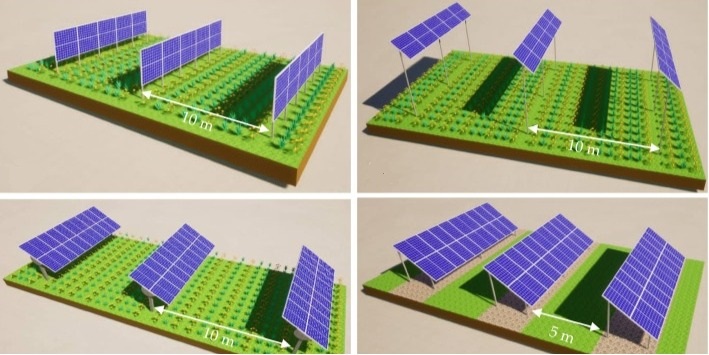Researchers in Sweden and Italy analyzed the economy of an-axis, vertical and increased PV systems for agrivoltaic applications, and find that overhead agrivoltaic systems can better perform the further south is installed. The return period of discount and the level of electricity were also calculated and compared.
Researchers from Sweden and Italy modeled the profitability and cost -effectiveness of different types of agrivoltaic (APV) systems for European crop rotations and locations.
With the help of a stochastic approach with Monte Carlo (MCA) simulations, which they described as a “powerful tool” to assess the effects of uncertainty of some economic input parameters on the PV project performance, they compared an axis, vertical and raised Fotovoltaics systems.
Het model voorspelde de winstgevendheid en kosteneffectiviteit van elk agrivoltaïsche systeem door belangrijke prestatie-indicatoren toe te passen, zoals de netto contante waarde (NPV), korting op de verlaagde terugverdientijd (DPBP) en evaluatiekosten (LCOE), volgens co-correspondende auteur Tekai Tekai Tekai Tekai Tekai Tekai Tekai Tekai Tekai Tekai Tekai Tekai Tekai Tekai Tekai Tekai Tekai Tekai Tekai Tekai Tekai Tekai Tekai Tekai Tekai Tekai Tekai Tekai Tekai Tekai Tekai Tekai Tekai Tekai Tekai Tekai Tekai Tekai Tekai Tekai Tekai Tekai Tekai Tekai Tekai Tekai Tekai Tekai Tekai Tekai Tekai Tekai Tekai Tekai Tekai Khalil Zidane.
“This approach offered an extensive economic assessment to support decision -making in Agrivoltaic development throughout Europe,” Zidane said PV -Magazinenoted that the study also focused on the potential performance of the three APV variations in Sweden, Denmark, Germany and Italy.
“In contrast to various previous studies that focused on a single system type, crop rotation, specific locations and certain costs or incomes, our goal was to give a more extensive analysis of the economic performance of Agrivoltaic systems,” Pietro Elia Campana, co-correcting author of the study, said PV -MagazineAdding that the MCA was possible with a wide range of inputs to determine their impact on economic profitability.
“It is interesting that our analysis has shown that Overhead -Grivoltaic systems performed better compared to vertical systems when we moved from north to south in Europe. This improvement was due to increased electricity production and higher electricity prices, which compensates for the higher initial investment costs,” Campana said.
Within the assumptions of the study, the APV system of one axis in Europe had a higher profitability and cost-effectiveness than vertical and increased setups. The LCO of the APV system with one axis was 20-25% lower than that of the vertical APV system and 30% lower than the increased APV setup, which indicates a greater cost-efficiency in electricity generation, according to the research, while the research NPV is “usually positive” throughout Europe for an axis, vertical and increased systems.
In addition, the DPBP for the APV system of one axis 25-30% was faster than for the vertical APV system and 35% faster than for the increased APV setup. In addition, the One-Axis APV system showed shorter DPBP and lower LCOe than the reference conventional soil mounted PV (CGMPV).
In Germany and Italy, the increased APV systems have higher profitability than vertical systems, because their increased electricity output compensates the higher costs related to their installation, the researchers noted.
With regard to Sweden and Denmark, vertical systems show a higher profitability, whereby systems in Denmark offer selling prices “considerably higher profitability as a result of increased electricity”.
The most important parameters that influence NPV variation in electricity agriculture and NPV electricity variation are the electricity sales prices, the PV system-specific costs and the real weighted average capital costs (WACC), the researchers noted.
Moreover, it was observed that the average crop rotation was the “most important parameter” that influences the agricultural NPV, while the LCOE project is mainly influenced by the PV system-specific cost, operating and maintenance costs and the real WACC.
The findings of the research are “particularly important for decision -makers and stakeholders involved in the development of agrivoltaic policy,” the researchers said.
Their work is described in “Economic evaluation of an axis, vertical and increased Agrivoltaic systems throughout Europe: a Monte Carlo analysis“Published in Applied energy. The researchers were from Mälardalen University in Sweden and Università Cattolica del Sacro Cuore in Italy.
Looking ahead, the teams are planning to continue to concentrate research efforts on Agrivoltaic systems, according to Zidane.
This content is protected by copyright and may not be reused. If you want to work with us and reuse part of our content, please contact: editors@pv-magazine.com.

